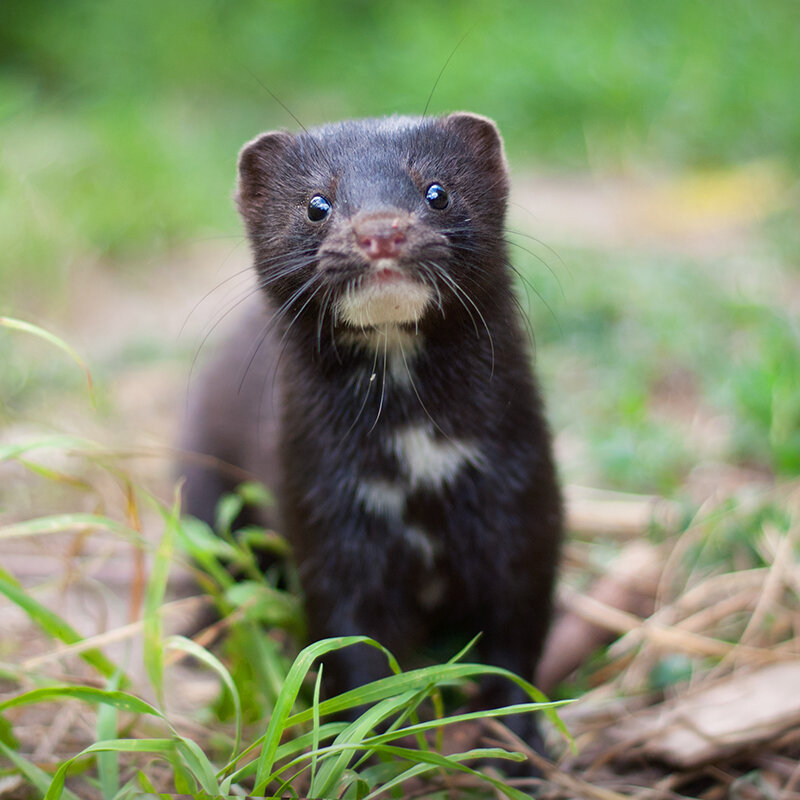American mink
Neovison vison
The mink is an invasive non-native species which escaped (or were intentionally freed) from fur farms in the 1950s and 1960s, and now breeds across most of the country. They are largely solitary animals but use a variety of vocal sounds when in contact with other individuals (e.g. squeaks and squeals).
It is a small, sleek mammal, with glossy dark brown-black fur, a narrow snout, a small, white chin and a white throat (a ‘bib’). They have a small, narrow ferret-like face. Their bodies measure c. 30 - 47cm in length, and their tails are c. 13 - 23cm in length.
Mink are good swimmers and their dens tend to be located close to the water. They use tree hollows, exposed root networks or rock crevices to create a den. They have one litter born in April/May of four to six kittens. They are blind, deaf and furless when born, but will be fully independent by 14 weeks of age. Mink are much more likely to be seen than the shy and secretive otter.
What they eat
Mink are voracious predators, feeding on anything they can catch, including ground-nesting seabirds, domestic fowl, molluscs, crustaceans and fish, and our native water voles. They can devastate populations of ground-nesting birds and have a hugely damaging impact on water vole numbers. They will hunt both on land and in water and have excellent eyesight and sensitive whiskers.
Where and when to see them
Mink can be seen all year round, and although they are mainly nocturnal they are also active throughout the day. They are strongly associated with aquatic habitats and dens tend to be positioned near the water close to their main food source.
!Take care near waterbodies!
View a American mink 10km distribution map of Wales
Legal status
American mink is listed under Schedule 9 to the Wildlife and Countryside Act 1981 with respect to England, Wales and Scotland. It is an offence to release or allow the escape of this species into the wild.
Field Signs
Droppings/spraints
Mink spraints have a particularly pungent, foul odour (described as burnt rubber or rotten meat) and are very distinct from Otter droppings, which smell like a mixture of Jasmine tea and fresh fish. Mink spraints often have a twisted, tapered appearance and contain fur, bones and feathers.
Footprints
American mink footprints can be found in soft sand and mud running alongside the soft edges of rivers, streams and other water bodies. They are five-toed and often show claw impressions that radiate out from a crescent-shaped central pad. The claws can sometimes join with the toepad to create a teardrop shaped print. The footprints measure about 3 - 3.5cm in width and 2.5 - 4cm in length.
Similar species
Otter
The otter is a large semi-aquatic mammal with a long streamlined body, a long powerful cylindrical tail, short legs, and large webbed feet. They can measure up to c. 1.5m long and can weigh up to 12kg. They have a large flat head, and are brown in colour with a light brown/creamy-coloured chin and throat.
In the water, otters are agile swimmers, and on land can run surprisingly fast over short distances. Otters swim with most of their body under water, only their head and tail are visible and they create a bow wave when swimming. Mink swim with half their body out of the water, and do not create a bow wave.
Otter droppings (also called spraints or scat) are black and tarry, and often contain fish and amphibian bones, fish scales and other animal remains. When fresh, they have a sweet, jasmine–like, fishy odour. They are used as territorial markers and are often found on prominent logs, rocks, bridges, storm drains and culverts. A jelly-like substance (anal-jelly) is also often deposited in prominent places.
Otter footprints are large (c. 6cm wide) and have 5 oval toe marks with/without claw impressions. Their large tail may also leave an impression on soft ground.
Polecat (Mustela putorius)
The polecat is of a very similar size to mink, but they have white tips to ears, and white above their top lip and nose creating a white mask. They look like they have a dark bandit mask on their face.
Stoats & Weasels
Weasels and stoats are much smaller than mink.
The weasel is very small with short legs and a slender body (17-24cm). The fur is chestnut brown on the back and head with a creamy white belly, and the division between brown and cream is irregular and spotted. The tail is short (3-6cm) and is a uniform chestnut brown colour with no black tip.
The stoat is slightly larger (20-30cm) than the weasel and has a longer tail (7-12cm) with a distinctive black tip. It is a sandy brown colour on the back and head with a cream belly, and the division between brown and cream fur is straight.
Did you know?
Otter spraints have been found containing mink bones, and research suggests that otter numbers are on the increase whilst mink numbers are dropping, particularly in the western parts of the UK.

